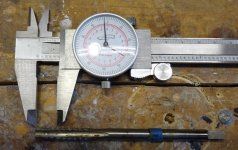Bill S. most likely hit the snail on the head when he mentioned fake pins.
I purchased some bad pins last year and they were exactly .004" off, imagine that, the same amount you mentioned.
It's either bad pins or bad on your part, I am going with the pins and not you.
It sounds like you knew your tailstock was hi, many people never know that about lathes, brand new lathes will have tailstocks that are hi, that is why we bore after drilling.
Edit; You mentioned the pin was straight until you removed the tailstock. Bingo, I believe its your tailstock forcing it out of center and holding it in a stressed position, it relaxes when you remove it. It's either bad pins or your tailstock.
